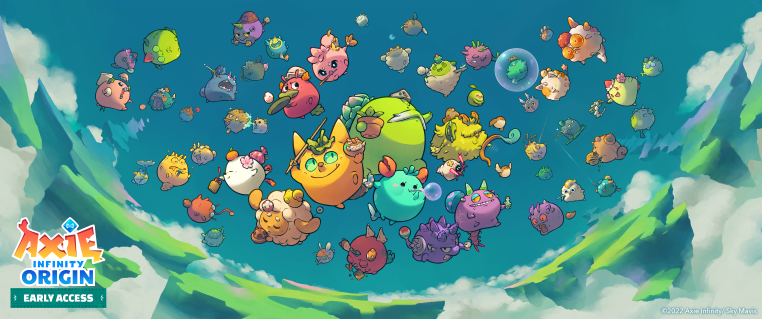The popular play-to-earn (P2E) crypto game Axie Infinity scaled to new heights in 2021, with huge spikes in transaction volumes and revenue and gaining millions of community members. But as we’re almost halfway through 2022, a question stands: Is Axie holding up to its hype?
Axie was launched by its parent company Sky Mavis in May 2018 but didn’t pick up steam until the second half of last year.
Its co-founder Jeff “Jiho” Zirlin told TechCrunch that “2021 was a year of growth and scaling,” while “2022 is a year of building, shipping products, and delivering better and more accessible gameplay experiences.”
Zirlin said he used to go to conferences and talk about Axie until he lost his voice. Now, it needs no introduction as one of the biggest and most well-known play-to-earn games in the crypto space, he said.
“We had this amazing growth cycle that put us on the map, got us resources to turn this into a decades-long journey,” Zirlin said. “Right now, I think we’re in the midst of building out the products that will get us to the next growth cycle.”
For the uninitiated, Axie Infinity is a crypto-focused gaming universe and platform with creatures, or Axies, that players can buy or collect as pets and then use to battle, breed and raise for crypto rewards.
At its peak, the fully diluted market capitalization (for Axie’s AXS token) was about $16.7 billion and its total revenue from in-game purchases and market fees paid was $364.4 million in August 2021, according to data on Token Terminal. From its apex, the market cap has dropped 19.76% to $13.4 billion and its total revenue has also fallen about 99% to $2.5 million in April 2022, the data shows.
“Crypto is very cyclical, and sometimes you’re in a growth cycle and other times are times when you have to build,” Zirlin said. “You can’t have exponential growth all the time; there is a refractory period.”
Earlier this year, Axie Infinity’s Ronin Network suffered an exploit valued at roughly $625 million at the time, making it the largest crypto heist to date, according to REKT Database. Shortly after the hack, Sky Mavis raised about $150 million in a round led by crypto exchange Binance to compensate victims.
“We made mistakes because we were going so fast, rushing for more adoption, and I think that the whole saga from last month will be seen as a badge of honor for those going through it,” Zirlin said. “It’s hard to think about counterfactuals, but the obvious answer here is to invest more in security for Ronin and prioritizing that [going forward].”
Even though its market cap and revenue have dropped drastically from their peaks, the company is still flying much higher than it was a year earlier — Axie’s market cap is up 228.3% and total revenue is up a whopping 50,950.8% from the same time last year, Token Terminal data shows.
The game is also bringing on new users. Last month, the company launched Axie Infinity: Origin, a free-to-play version of the game in an effort to appeal to more users who might want to take it for a test run first, Zirlin said.
“I think having free starter Axies is an important moment for NFTs, because people can fall in love with the IP and universe and try it out and see if it’s for them before making huge economic decisions,” Zirlin said.
Over 700,000 Axies are listed on the game’s marketplace — some are as low as $8, or 0.003 ether, and others are listed for hundreds of thousands of ether, at billions of dollars (though that doesn’t mean they’re being bought at that price; someone out there is pushing their luck.)
The community had about 45,000 Axie holders on April 24, 2021, and that number had increased about 5,567% to 2.55 million to April 24 this year, Zirlin said. The game’s daily active users (DAUs) also rose 2,926% to 1.15 million from 38,000 users during the same time frame, he added.
In general, play-to-earn games require an investment anywhere from $1 to hundreds of dollars in cryptocurrency to begin playing, though some are free to start. The play-to-earn ecosystem allows gamers the potential to create more value for their investments through in-game activities and rewards like additional cryptocurrency, an NFT, or the value of their initial investment increasing. Unlike traditional games, P2E encourages users to earn rewards and trade items for value, in addition to having fun.
In the past year, tons of funds were launched for the crypto gaming industry, from GameStop and Immutable’s $100 million joint fund for gaming NFTs in February 2022, to decentralized blockchain TRON creating a $300 million fund to invest in GameFi in August 2021. More recently, Framework Ventures announced a $400 million fund with a focus on blockchain gaming in April 2022.
As Axie moves toward the second half of this year, it’s planning on building its digital game environment to be similar to the physical world, Zirlin said. People will be able to log on to Axie to make friends, socialize, play, compete, and also work and earn a living, he said.
“There’s more spending from the physical world being shifted to digital environments,” Zirlin said. “It could be hard for certain generations to appreciate that, but more time is being spent in front of screens, so that’s a major shift that is making more people think about the metaverse as a shift from the physical to the digital.”
Overall, Zirlin expects there to be a major realignment, with gamers getting their emotions and actions rewarded through a purely digital environment. The game provides users with similar experiences to popular traditional games like Animal Crossing or Pokémon, where gamers can travel to complete daily quests or battle other Axies, among other objectives.
Author
Administraroot

